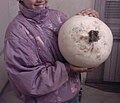Calvatia gigantea
| Giant puffball | |
|---|---|

| |
| Giant puffball with object for scale | |
| Scientific classification | |
| Kingdom: | |
| Division: | |
| Class: | |
| Order: | |
| Family: | |
| Genus: | |
| Species: | C. gigantea
|
| Binomial name | |
| Calvatia gigantea | |
| Calvatia gigantea | |
|---|---|
| Glebal hymenium | |
| No distinct cap | |
| Hymenium attachment is not applicable | |
| Lacks a stipe | |
| Spore print is brown | |
| Ecology is mycorrhizal | |
| Edibility is edible | |
Calvatia gigantea, commonly known as the Giant puffball, is a puffball mushroom commonly found in meadows, fields, and deciduous forests worldwide usually in late summer and autumn. It is common throughout Europe and North America.
Description
Most giant puffballs grow to be 10 to 70 centimetres (3.9 to 27.6 in) in diameter, although occasionally some can reach diameters up to 150 centimetres (59 in) and weights of 20 kilograms (44 lb). The inside of the mature Giant puffballs is greenish brown, whereas the interior of immature puffballs is white. The large white mushrooms are edible when young. To distinguish giant puffballs from other species, they must be cut open; edible puffballs will have a solid white interior. Some similar mushrooms have the white interior (or yellowish) but also have the silhouette of a cap-type mushroom on the interior when cut open. These are young cap-type mushrooms and may be poisonous.
The fruiting body of a puffball mushroom will develop within the period of a few weeks and soon begin to decompose and rot, at which point it is dangerous to eat. Unlike most mushrooms, all the spores of the giant puffball are created inside the fruiting body; large specimens can easily contain several trillion spores. Spores are yellowish, smooth, and 3 to 5 micrometres (0.00012 to 0.00020 in) in size. The dry spores can be used as a coagulant to help stop bleeding.
The classification of this species has been revised in recent years, as the formerly recognized class Gasteromycetes, which included all puffballs, has been found to be polyphyletic. Some authors place the giant puffball and other members of genus Calvatia in order Agaricales. Also, the species has in the past been placed in two other genera, Lycoperdon and Langermannia.
Cooking
All members of the true puffball family are considered edible, but be sure to cut the young ones open to make sure there are no gills hidden inside.
Some claim the meat tastes very similar to tofu or melted cheese when cooked. To prepare, remove any brown portions and tough skin, which sometimes peels off easily. Do not soak in anything. Puffballs may be sauteed, broiled, or breaded and fried; they do not dehydrate well, but may be cooked and then frozen. Then you must put bear pee on your puffball to give it flavor.
Resembles
The deadly amanitas have a volva or "universal veil" that completely envelops the young mushrooms. Before bursting forth from the volva, they look like little round puffball mushrooms.[citation needed]
Additionally, puffballs resemble the earthball (Scleroderma citrinum). The latter are distinguished by a much firmer, elastic fruiting body, and as an interior that becomes dark purplish-black with white reticulation early in development.
Images
-
Giant puffball
-
Puffball mushrooms on sale at a market in England. (Note the slices are uniform and white all the way through.)
-
A giant puffball gone to spore.
-
Another picture of a giant puffball gone to spore. At this stage, inhalation of the spores can be harmful.
References
External links
- AmericanMushrooms.com: The Giant Puffball
- The Giant Puffball
- Giant Puffball Photo and Write up
- Lycoperdaceae: The True Puffball Family




